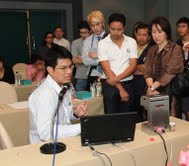Home > Press > Sensor technology helps standardize food industry
 |
| Rungroj Maolanon (seated) giving a talk on NanoNose technology to private sector groups. |
Abstract:
Researchers at NANOTEC, King Mongkut's Institute of Technology Ladkrabang (KMITL)(College of Nanotechnology), and Mahidol University have collaborated to develop an electronic nose (NanoNose) to help local food industry in areas related to standardizing smell, which is one of the key sensory perceptions for the food industry.
Sensor technology helps standardize food industry
Pathumthani, Thailand | Posted on July 10th, 2012The Thai food industry is a multi billion dollar industry and account for 3% of the total world food export. The drawback of this industry is that it is prone to various sensitive aspects such as safety and quality. "We utilized knowledge in areas related to surface analysis and nanaocoating to existing sensor technology to developed an electronic nose (NanoNose) which is a bio-mimetic device based on series of gas sensors to provide a quasi-quantitative measure of the signature of smell" said Rungroj Maolanon, a researcher at Nanomolecular Sensor Lab at NANOTEC and team member. "In a way similar to human nose, NanoNose allow analysis of the headspace (volatile compounds) generated by liquid, gaseous or solid samples".
NanoNose provides a qualitative measure of smell and identifies samples through a learning process. It compares each fingerprint to known chemical substance patterns in a data library and either matches the fingerprint, or records the sample as a new pattern. The data analysis employed the Principal Component Analysis (PCA), which classify the data according the recognition pattern of sensor array. The electrical response of each sensor is generated by the replacement of absorbed oxygen molecules by exposed chemical vapors to induce free charge on metal oxide sensor surface.
From this research collaboration, different variation of NanoNose applications can be applied to agriculture, food science, health and environmental monitoring. The capability of the device to distinguish different types of smell has been demonstrated on fine scents such as perfume, alcoholic beverages, and coffee aroma. In the medical industry, breath analyses using NanoNose can be use to detect infections, gastrointestinal disorders and liver disease.
####
For more information, please click here
Contacts:
Ramjitti Indaraprasirt
Manager
Public Relations Section
NANOTEC
02-564-7100 ext: 6617
Copyright © NANOTEC
If you have a comment, please Contact us.Issuers of news releases, not 7th Wave, Inc. or Nanotechnology Now, are solely responsible for the accuracy of the content.
| Related News Press |
News and information
![]() Researchers develop molecular qubits that communicate at telecom frequencies October 3rd, 2025
Researchers develop molecular qubits that communicate at telecom frequencies October 3rd, 2025
![]() Next-generation quantum communication October 3rd, 2025
Next-generation quantum communication October 3rd, 2025
![]() "Nanoreactor" cage uses visible light for catalytic and ultra-selective cross-cycloadditions October 3rd, 2025
"Nanoreactor" cage uses visible light for catalytic and ultra-selective cross-cycloadditions October 3rd, 2025
Sensors
![]() Sensors innovations for smart lithium-based batteries: advancements, opportunities, and potential challenges August 8th, 2025
Sensors innovations for smart lithium-based batteries: advancements, opportunities, and potential challenges August 8th, 2025
![]() Quantum engineers ‘squeeze’ laser frequency combs to make more sensitive gas sensors January 17th, 2025
Quantum engineers ‘squeeze’ laser frequency combs to make more sensitive gas sensors January 17th, 2025
Discoveries
![]() Researchers develop molecular qubits that communicate at telecom frequencies October 3rd, 2025
Researchers develop molecular qubits that communicate at telecom frequencies October 3rd, 2025
![]() Next-generation quantum communication October 3rd, 2025
Next-generation quantum communication October 3rd, 2025
![]() "Nanoreactor" cage uses visible light for catalytic and ultra-selective cross-cycloadditions October 3rd, 2025
"Nanoreactor" cage uses visible light for catalytic and ultra-selective cross-cycloadditions October 3rd, 2025
Announcements
![]() Rice membrane extracts lithium from brines with greater speed, less waste October 3rd, 2025
Rice membrane extracts lithium from brines with greater speed, less waste October 3rd, 2025
![]() Researchers develop molecular qubits that communicate at telecom frequencies October 3rd, 2025
Researchers develop molecular qubits that communicate at telecom frequencies October 3rd, 2025
![]() Next-generation quantum communication October 3rd, 2025
Next-generation quantum communication October 3rd, 2025
![]() "Nanoreactor" cage uses visible light for catalytic and ultra-selective cross-cycloadditions October 3rd, 2025
"Nanoreactor" cage uses visible light for catalytic and ultra-selective cross-cycloadditions October 3rd, 2025
Food/Agriculture/Supplements
![]() New imaging approach transforms study of bacterial biofilms August 8th, 2025
New imaging approach transforms study of bacterial biofilms August 8th, 2025
![]() SMART researchers pioneer first-of-its-kind nanosensor for real-time iron detection in plants February 28th, 2025
SMART researchers pioneer first-of-its-kind nanosensor for real-time iron detection in plants February 28th, 2025
![]() Silver nanoparticles: guaranteeing antimicrobial safe-tea November 17th, 2023
Silver nanoparticles: guaranteeing antimicrobial safe-tea November 17th, 2023
Research partnerships
![]() Lab to industry: InSe wafer-scale breakthrough for future electronics August 8th, 2025
Lab to industry: InSe wafer-scale breakthrough for future electronics August 8th, 2025
![]() HKU physicists uncover hidden order in the quantum world through deconfined quantum critical points April 25th, 2025
HKU physicists uncover hidden order in the quantum world through deconfined quantum critical points April 25th, 2025
|
|
||
|
|
||
| The latest news from around the world, FREE | ||
|
|
||
|
|
||
| Premium Products | ||
|
|
||
|
Only the news you want to read!
Learn More |
||
|
|
||
|
Full-service, expert consulting
Learn More |
||
|
|
||








